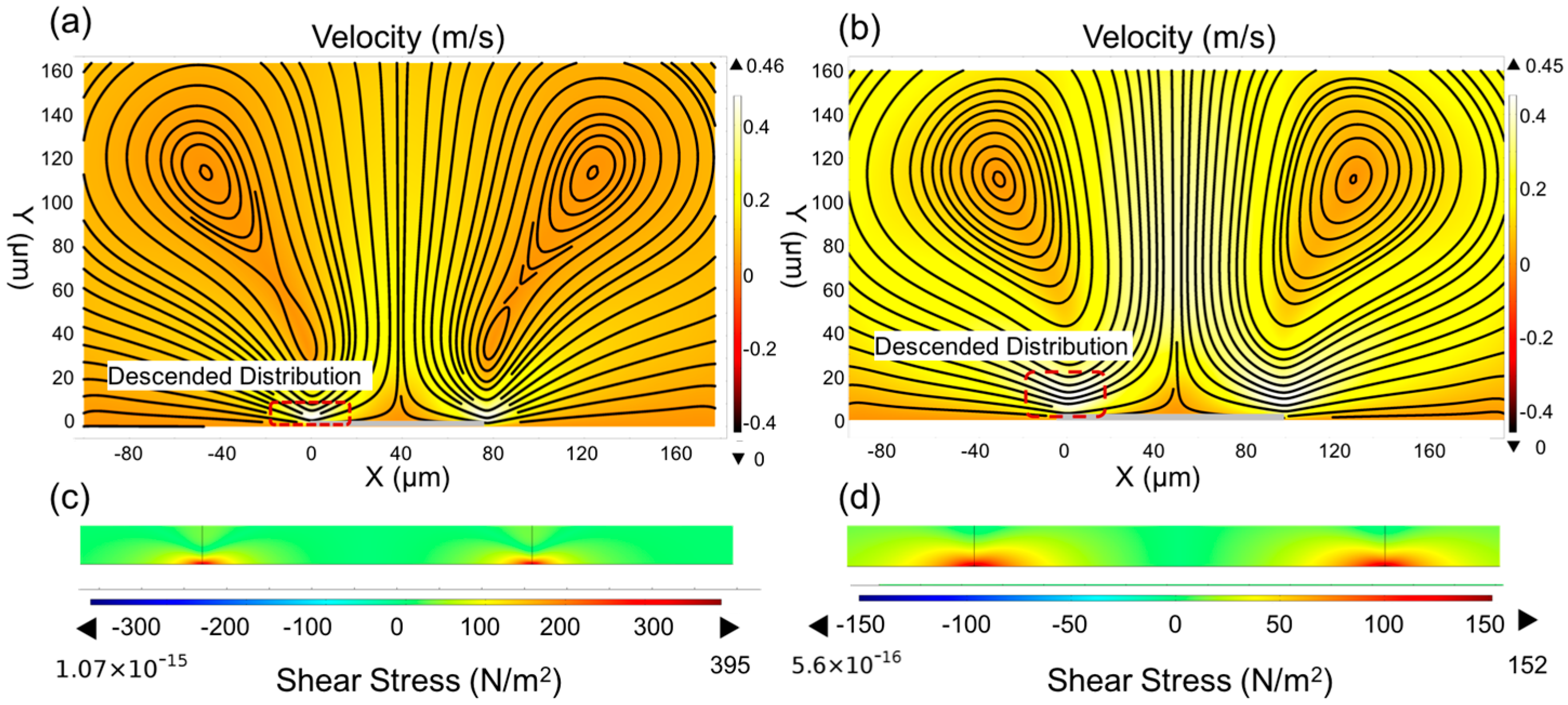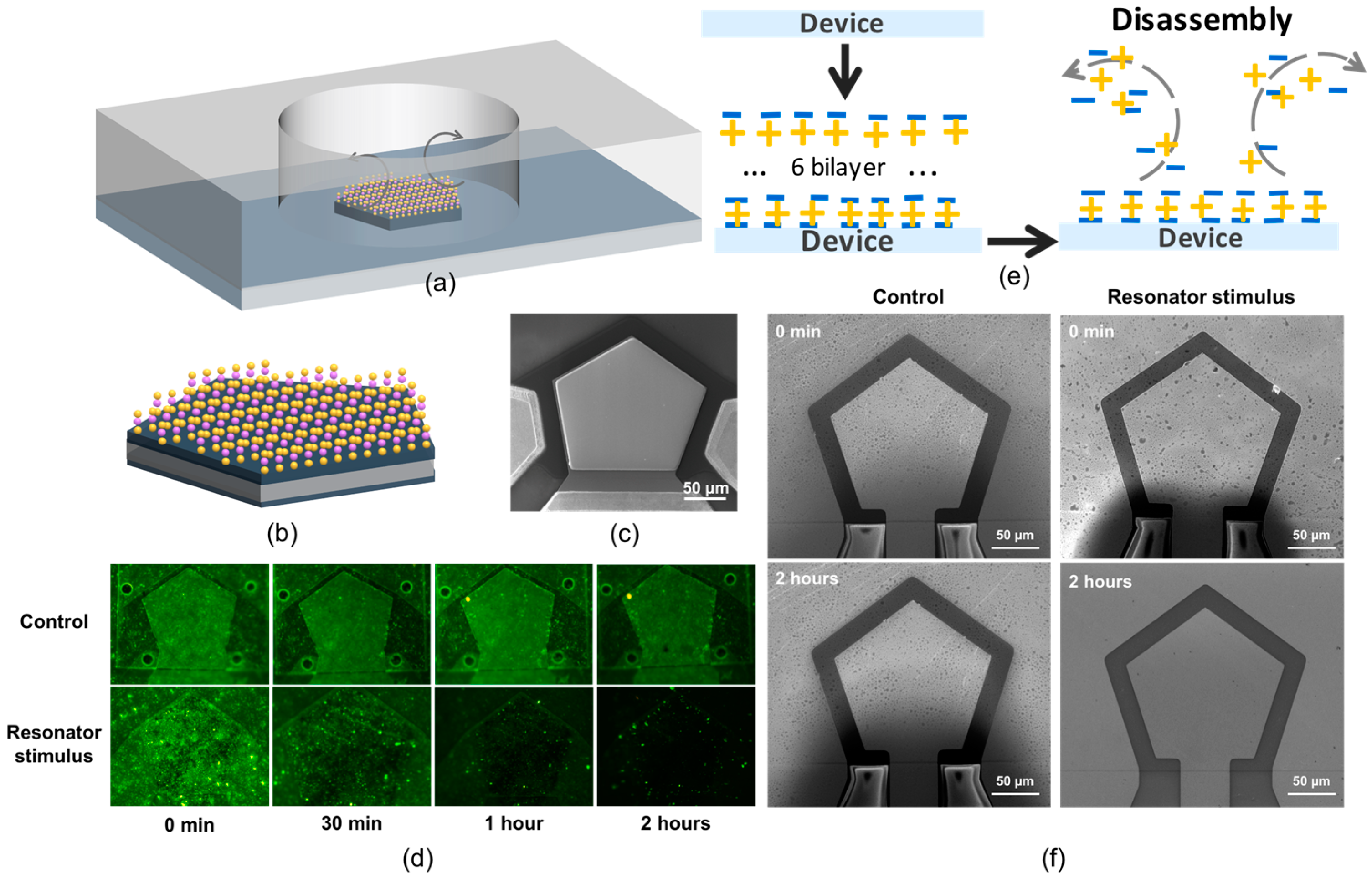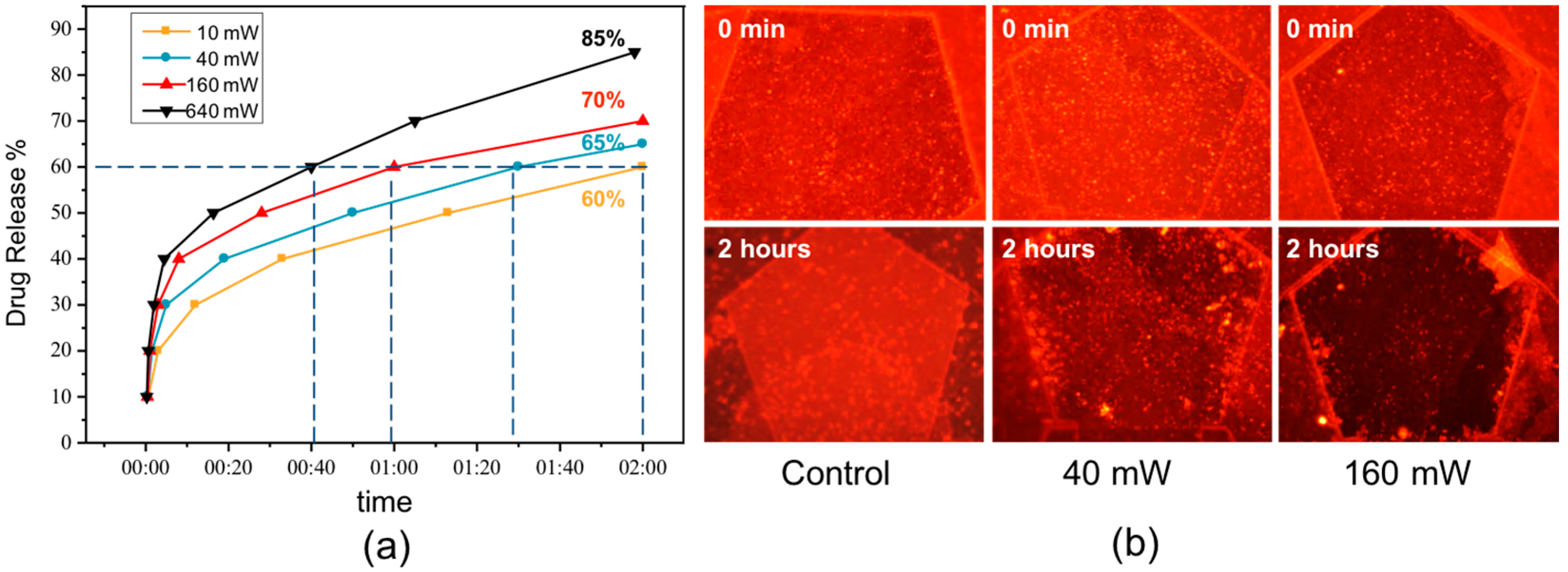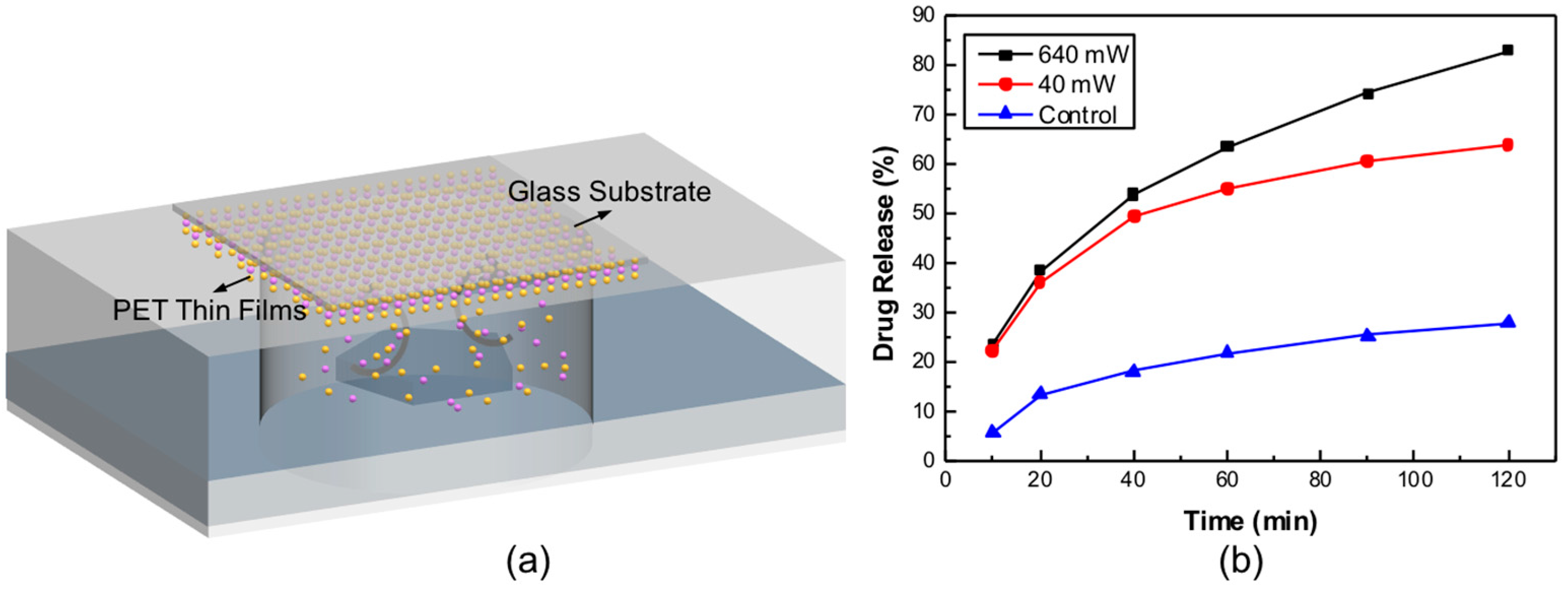Acoustically Triggered Disassembly of Multilayered Polyelectrolyte Thin Films through Gigahertz Resonators for Controlled Drug Release Applications
Abstract
:1. Introduction
2. Materials and Methods
2.1. Materials
2.2. Device Fabrication
2.3. Polyelectrolyte Multilayers Preparation and DOX Loading
2.4. Release System
2.5. Assessment of the DOX Release
2.6. SEM Characterization of the Thin Films
3. Results
3.1. Theory Consideration
3.2. Triggered PET Surface Disassembly
3.3. Controlled DOX Release
4. Discussion
5. Conclusions
Supplementary Materials
Acknowledgments
Author Contributions
Conflicts of Interest
References
- Anderson, C.; Bates, I.; Brock, T. Seven billion humans and 98 trillion medicine doses. Am. J. Pharm. Educ. 2011, 75, 194. [Google Scholar] [CrossRef] [PubMed]
- Langer, R. Drug delivery and targeting. Nature 1998, 392, 5–10. [Google Scholar] [PubMed]
- Hua, A.; Jones, S.A.; Villiers, M.M.D.; Lvov, Y.M. Nano-encapsulation of furosemide microcrystals for controlled drug release. J. Control. Release 2003, 86, 59–68. [Google Scholar]
- Loira-Pastoriza, C.; Todoroff, J.; Vanbever, R. Delivery strategies for sustained drug release in the lungs. Adv. Drug Deliv. Rev. 2014, 75, 81–91. [Google Scholar] [CrossRef] [PubMed]
- Donath, E.; Sukhorukov, G.B.; Caruso, F.; Davis, S.A.; Möhwald, H. Novel hollow polymer shells by colloid-templated assembly of polyelectrolytes. Angew. Chem. Int. Ed. 1998, 37, 2201–2205. [Google Scholar] [CrossRef]
- Zhang, S. Fabrication of novel materials through molecular self-assembly. Nat. Biotechnol. 2003, 21, 1171–1178. [Google Scholar] [CrossRef] [PubMed]
- Lvov, Y.; Decher, G.; Moehwald, H. Assembly, structural characterization, and thermal behavior of layer-by-layer deposited ultrathin films of poly(vinyl sulfate) and poly(allylamine). Langmuir 1993, 9, 481–486. [Google Scholar] [CrossRef]
- Kotov, N.A.; Dekany, I.; Fendler, J.H. Layer-by-layer self-assembly of polyelectrolyte-semiconductor nanoparticle composite films. J. Phys. Chem. 1995, 99, 13065–13069. [Google Scholar] [CrossRef]
- Tang, Z.; Wang, Y.; Podsiadlo, P.; Kotov, N.A. Biomedical applications of layer-by-layer assembly: From biomimetics to tissue engineering. Adv. Mater. 2007, 18, 3203–3224. [Google Scholar] [CrossRef]
- Liu, X.Q.; Picart, C. Layer-by-layer assemblies for cancer treatment and diagnosis. Adv. Mater. 2016, 28, 1295–1301. [Google Scholar] [CrossRef] [PubMed]
- Burke, S.E.; Barrett, C.J. Ph-responsive properties of multilayered poly(l-lysine)/hyaluronic acid surfaces. Biomacromolecules 2003, 4, 1773–1783. [Google Scholar] [CrossRef] [PubMed]
- Sui, Z.; Schlenoff, J.B. Phase separations in ph-responsive polyelectrolyte multilayers: Charge extrusion versus charge expulsion. Langmuir 2004, 20, 6026–6031. [Google Scholar] [CrossRef] [PubMed]
- Chaturbedy, P.; Jagadeesan, D.; Eswaramoorthy, M. Ph-sensitive breathing of clay within the polyelectrolyte matrix. ACS Nano 2010, 4, 5921–5929. [Google Scholar] [CrossRef] [PubMed]
- Malinova, V.; Wandrey, C. Loading polyelectrolytes onto porous microspheres: Impact of molecular and electrochemical parameters. J. Phys. Chem. B 2007, 111, 8494–8501. [Google Scholar] [CrossRef] [PubMed]
- Mendes, P.M. Stimuli-responsive surfaces for bio-applications. Chem. Soc. Rev. 2008, 37, 2512–2529. [Google Scholar] [CrossRef] [PubMed]
- Rydzek, G.; Thomann, J.S.; Ben, A.N.; Jierry, L.; Mésini, P.; Ponche, A.; Contal, C.; El Haitami, A.E.; Voegel, J.C.; Senger, B. Polymer multilayer films obtained by electrochemically catalyzed click chemistry. Langmuir 2010, 26, 2816–2824. [Google Scholar] [CrossRef] [PubMed]
- Büscher, K.; Graf, K.; Ahrens, H.; Helm, C.A. Influence of adsorption conditions on the structure of polyelectrolyte multilayers. Langmuir 2002, 18, 3585–3591. [Google Scholar] [CrossRef]
- Steitz, R.; Leiner, V.; Tauer, K.; Khrenov, V.; Klitzing, R.V. Temperature-induced changes in polyelectrolyte films at the solid–liquid interface. Appl. Phys. A 2002, 74, s519–s521. [Google Scholar] [CrossRef]
- Köhler, K.; Shchukin, D.G.; Möhwald, H.; Sukhorukov, G.B. Thermal behavior of polyelectrolyte multilayer microcapsules. 1. The effect of odd and even layer number. J. Phys. Chem. B 2005, 109, 18250–18259. [Google Scholar] [CrossRef] [PubMed]
- Skirtach, A.G.; Antipov, A.A.; Shchukin, D.G.; Sukhorukov, G.B. Remote activation of capsules containing Ag nanoparticles and IR dye by laser light. Langmuir Acs J.Surf. Colloids 2004, 20, 6988–6992. [Google Scholar] [CrossRef] [PubMed]
- Xia, T.; Li, J.; Möhwald, H. Self-assembly, optical behavior, and permeability of a novel capsule based on an azo dye and polyelectrolytes. Chemistry 2004, 10, 3397–3403. [Google Scholar]
- Koo, H.Y.; Lee, H.J.; Kim, J.K.; Choi, W.S. UV-triggered encapsulation and release from polyelectrolyte microcapsules decorated with photoacid generators. J. Mater. Chem. 2010, 20, 3932–3937. [Google Scholar] [CrossRef]
- Henry, S.; Mcallister, D.V.; Allen, M.G.; Prausnitz, M.R. Microfabricated microneedles: A novel approach to transdermal drug delivery. J. Pharm. Sci. 1998, 87, 922–925. [Google Scholar] [CrossRef] [PubMed]
- Mcallister, D.V.; Allen, M.G.; Prausnitz, M.R. Microfabricated microneedles for gene and drug delivery. Annu. Rev. Biomed. Eng. 2000, 2, 289–313. [Google Scholar] [CrossRef] [PubMed]
- Rajeswari, N.R.; Malliga, P. Design of mems based microneedle for drug delivery system. Procedia Eng. 2014, 97, 2001–2010. [Google Scholar] [CrossRef]
- Van Lintel, H.T.G.; Van De Pol, F.C.M.; Bouwstra, S. A piezoelectric micropump based on micromachining of silicon. Sens. Actuators 1988, 15, 153–167. [Google Scholar] [CrossRef]
- Van De Pol, F.C.M.; Van Lintel, H.T.G.; Elwenspoek, M.; Fluitman, J.H.J. A thermopneumatic micropump based on micro-engineering techniques. Sens. Actuators A Phys. 1990, 21, 198–202. [Google Scholar] [CrossRef]
- Bourouina, T.; Grandchamp, J.P. Design and simulation of an electrostatic micropump for drug-delivery applications. J. Micromech. Microeng. 1997, 7, 186–188. [Google Scholar] [CrossRef]
- Tam, C.K.W.; Ju, H.; Walker, B.E. Numerical simulation of a slit resonator in a grazing flow under acoustic excitation. J. Sound Vib. 2008, 313, 449–471. [Google Scholar] [CrossRef]
- Sukhorukov, G.B.; Donath, E.; Davis, S.; Lichtenfeld, H.; Caruso, F.; Popov, V.I.; Möhwald, H. Stepwise polyelectrolyte assembly on particle surfaces: A novel approach to colloid design. Polym. Adv. Technol. 1998, 9, 759–767. [Google Scholar] [CrossRef]




© 2016 by the authors. Licensee MDPI, Basel, Switzerland. This article is an open access article distributed under the terms and conditions of the Creative Commons Attribution (CC-BY) license ( http://creativecommons.org/licenses/by/4.0/).
Share and Cite
Zhang, Z.; Tang, Z.; Liu, W.; Zhang, H.; Lu, Y.; Wang, Y.; Pang, W.; Zhang, H.; Duan, X. Acoustically Triggered Disassembly of Multilayered Polyelectrolyte Thin Films through Gigahertz Resonators for Controlled Drug Release Applications. Micromachines 2016, 7, 194. https://doi.org/10.3390/mi7110194
Zhang Z, Tang Z, Liu W, Zhang H, Lu Y, Wang Y, Pang W, Zhang H, Duan X. Acoustically Triggered Disassembly of Multilayered Polyelectrolyte Thin Films through Gigahertz Resonators for Controlled Drug Release Applications. Micromachines. 2016; 7(11):194. https://doi.org/10.3390/mi7110194
Chicago/Turabian StyleZhang, Zhixin, Zifan Tang, Wenpeng Liu, Hongxiang Zhang, Yao Lu, Yanyan Wang, Wei Pang, Hao Zhang, and Xuexin Duan. 2016. "Acoustically Triggered Disassembly of Multilayered Polyelectrolyte Thin Films through Gigahertz Resonators for Controlled Drug Release Applications" Micromachines 7, no. 11: 194. https://doi.org/10.3390/mi7110194






